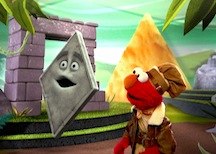STEAM & Media Literacy
By Frank W. Baker
There has been a lot of talk lately about adding A (art) to STEM (Science, Technology, Engineering and Math) education. And a lot of this talk originates from the arts community itself, which sees art missing in the conversations about what is important for students to know and learn in the 21st century. Bravo, I say, to those art people.
(Under full disclosure, I should reveal that I have recently become one of those advocating arts educators, because of my involvement in writing state teaching standards for art and authoring supporting documents for those teachers who are going to be teaching media arts and media literacy – new in South Carolina’s arts standards.)
I am also a strong proponent of putting that A into STEM because I see many STEAM connections in what I teach: media literacy. Math and science, like media literacy, encourage problem-solving, inquiry and critical thinking. So do the arts.
At my website The Media Literacy Clearinghouse, I have a long-standing page dedicated to Math and Science Connections to Media Literacy, which includes readings and resources. More than a decade ago, I wrote about how math and science teachers use the media (“Media Literacy: Yes, It Fits in Math and Science Classrooms,” ENC Focus, 2001) and how the media is used to communicate important science/engineering ideas and concepts to the public.
Arts teachers and STEM
I recently conducted a workshop with arts educators. I was curious: How much did they know (or care) about teaching STEM? Is STEM even on their radar screens? Did they receive any STEM training when they attended college? Do their textbooks prepare them to explore STEM relationships to art, dance, drama, media, music and more?
These were the questions I used to begin my workshop. I suggested that we all “dip our toes in” and see what happened.
I began with a trivia question. Many of our students use mp3 players, so I asked ‘what do the letters mp stand for?’ Most teachers answered: media player. Good guess, but wrong. One teacher had the right answer: he knew that mp is a shortening of mpeg and the mp stands for “motion picture,” because it was the Motion Picture Experts Group (MPEG) that invented the algorithm used to compress video and music, allowing these media to be played from hard drives. (Can you say math?)
As the teachers in the workshop introduced themselves, they were asked to share how they were already connecting their discipline to science, math and engineering. Perhaps to some readers’ surprise, this activity revealed that many of these arts educators were already beginning to help their students make STEM connections.
Media Arts are rooted in science
Since I had recently helped add “media literacy/media arts” into our state’s arts standards, that was the starting point for my presentation. Drawing an example from media arts, I noted that many of the professionals who make movies belong to The Academy of Motion Picture Arts & Sciences (the Oscar Award folks), and most movie makers consider themselves to be members of both the arts and the sciences communities. STEM, with its focus on engineering design principles that encompass science, math and technology, is certainly a good fit when it comes to film and video.
As we discussed motion pictures, I revealed that (traditionally) film is shot and played back at 24 frames-per-second (fps). I turned this into a math activity: how many frames are there in a minute, an hour, in 90 minutes. If Disney’s animated movie “Toy Story” is 77 minutes long, how many frames (animation cels) had to be created? The answer may surprise you and also tell you why, historically, it has taken so long to create an animated feature.
The frames-per-second standard for movies (in place since the 1920s) was in the news last year because directors James Cameron (Titanic, Avatar) and Peter Jackson (Lord of the Rings, The Hobbit) were both advocating for a radical change in filmmaking: starting to shoot their films at higher frame rates. Jackson, then filming The Hobbit, was shooting at 48 fps; Cameron planned to shoot Avatar 2 at 60 fps.
Why would they want or need to shoot at a higher frame rate?
In an interview, director Jackson said the higher frame rate would eliminate the blur that occurs during fast action and especially during fast movements of the camera. He added that 48 fps puts less strain on the eyes, especially when watching films in 3D. (A higher frame rate also means a change in how we view films on our TVs, computers, and other mobile devices – stand by for more developments.)
Exploring STEM through media lenses
Next I discussed visual literacy, and how important it is to help students understand how to “read” an image. Students using mobile phone cameras and small camcorders probably won’t learn about shutter speeds and f/stops, but those using more sophisticated cameras might. For this part of the workshop, I shared a short video on how a digital camera works: lots of science, technology and engineering in that one. So, I invited the teachers to construct a simple shoe box camera, demonstrating science principles of light and more.
In a discussion of math, I shared my “Math In The Media” website. I developed it years ago because I wanted to provide math educators with data and examples from pop culture and the news that could be incorporated into lessons (the monthly Consumer Price Index; the weekly Box Office figures, etc.). I chose TV ratings as the central theme on this site. Students get a chance to learn about and explore TV ratings/shares (which are really percentages) and begin to understand how they are generated, used and reported.
The more we talked, and shared, it was clear that many of these educators had already approached STEM, or elements of it, in their classrooms. They were very open to learning more from experts and from their peers.
What are some of the connections you see between STEM, media literacy and the media arts?
Frank W. Baker is a media literacy education consultant and the author of three books, including Media Literacy In the K-12 Classroom (ISTE, 2012). He contributed two chapters to the upcoming Mastering Media Literacy (Solution Tree, December 2013). In November 2013 he and two others received the National Telemedia Council‘s annual Jessie McCanse Award given for individual contribution to the field of media literacy over at least ten years He can be reached at fbaker1346@aol.com. Follow him on Twitter @fbaker.
Read science educator and MW blogger Anne Jolly’s take on STEM and STEAM in this recent post.




































